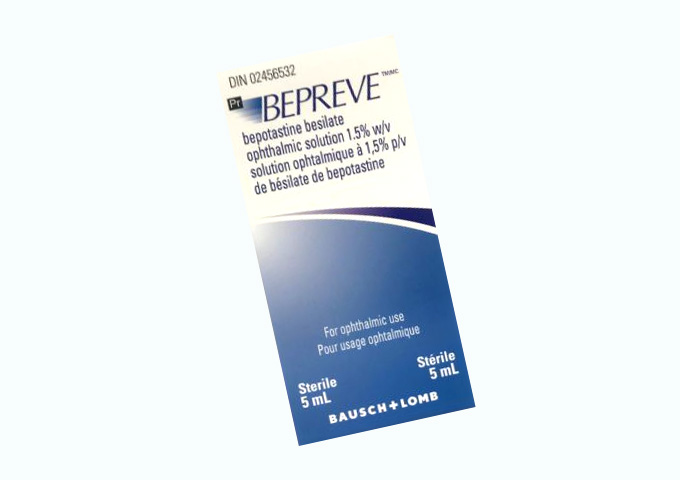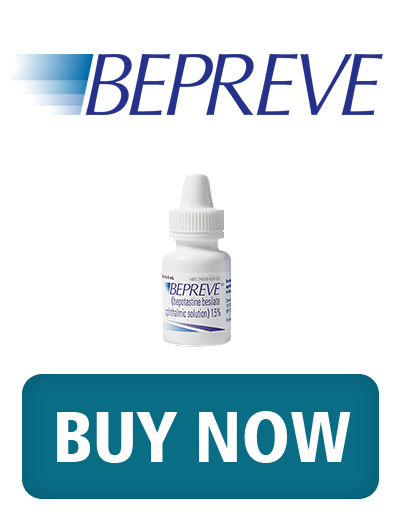Bepreve (Bepotastine)
Bepreve is a brand name for the prescription eye drops containing the active ingredient bepotastine besilate. It is an antihistamine that is used to treat itching associated with allergic conjunctivitis. Allergic conjunctivitis is an allergic reaction that affects the conjunctiva, the clear membrane that covers the white part of the eye and lines the inside of the eyelids.
Bepreve works by blocking the effects of histamine, which is a substance released by the body in response to an allergic reaction. Histamine causes the blood vessels to dilate and the tissues to swell, resulting in itching, redness, and other allergy-related symptoms.
Uses
As mentioned earlier, Bepreve is primarily used to treat itching associated with allergic conjunctivitis. Allergic conjunctivitis is an inflammation of the conjunctiva caused by an allergic reaction to substances like pollen, pet dander, dust mites, mold, or other allergens. The condition can lead to symptoms such as:
- Itching: This is the most common symptom of allergic conjunctivitis and can be quite bothersome.
- Redness: The eyes may appear red or bloodshot due to increased blood flow caused by the inflammation.
- Watery eyes: Allergic conjunctivitis can lead to excessive tearing.
- Swelling: The conjunctiva and eyelids may become swollen or puffy.
- Sensitivity to light: Some individuals may experience increased sensitivity to light (photophobia).
Bepreve, being an antihistamine, helps relieve these symptoms by blocking the effects of histamine, a chemical released by the body during an allergic reaction. By inhibiting histamine's action, Bepreve helps reduce itching and inflammation, providing relief to individuals suffering from allergic conjunctivitis.

Dosage
The dosage of Bepreve eye drops can vary based on the severity of the allergic conjunctivitis and individual patient factors. The typical recommended dosage for adults and children aged 2 years and older is one drop in the affected eye(s) twice daily, approximately 12 hours apart.
Here are some general guidelines for using Bepreve eye drops:
- Wash your hands thoroughly before handling the eye drops to prevent contamination.
- Tilt your head back slightly and pull down the lower eyelid to create a small pocket.
- Hold the dropper close to the eye without touching it, and squeeze the prescribed number of drops into the pocket.
- Close your eyes gently for about 1 to 2 minutes to allow the eye drops to spread evenly over the eye's surface.
- If using Bepreve in both eyes, repeat the process for the other eye.
- Replace the cap on the eye drop bottle tightly after use.
It is crucial to follow your doctor's instructions regarding the exact dosage and frequency of administration. If you miss a dose, take it as soon as you remember. However, if it is almost time for the next dose, skip the missed dose and continue with the regular schedule. Do not double the dose to catch up.
Overdose
If you suspect an overdose of Bepreve eye drops or accidentally use more than the prescribed amount, it is essential to seek immediate medical attention or contact your local poison control center.
Overdosing on Bepreve may lead to increased side effects, which can be more severe than the usual side effects experienced at the recommended dosage. Some potential symptoms of an overdose may include:
- Severe eye irritation or burning sensation
- Excessive tearing
- Eye redness
- Eye pain or discomfort
- Blurred vision
- Unusual or unexpected taste in the mouth
- Headache
- Dizziness
If you or someone else has ingested Bepreve orally or used it inappropriately, do not hesitate to seek medical attention. In case of accidental ingestion, call your local poison control center immediately for guidance.
Precautions
When using Bepreve eye drops, it is important to take certain precautions to ensure safe and effective treatment. Here are some key precautions to consider:
- Allergies: If you experience an allergic reaction after using Bepreve, such as rash, itching, swelling, severe dizziness, or difficulty breathing, seek immediate medical attention.
- Contact lenses: If you wear contact lenses, remove them before using Bepreve eye drops. You can reinsert your lenses after at least 10 minutes. Eye drops contains a preservative that may be absorbed by soft contact lenses, leading to eye irritation.
- Other eye medications: Using multiple eye medications too close together can decrease their effectiveness.
- Driving and operating machinery: Eye drops may cause blurred vision or other visual disturbances in some individuals. If you experience such effects, avoid driving, operating machinery, or performing activities that require clear vision until your vision has returned to normal.
- Systemic absorption: Although Remedy is primarily an eye drop medication, some of the drug may be absorbed systemically (into the bloodstream) after application. This could potentially interact with other medications you are taking or exacerbate certain medical conditions.
- Eye infections or injuries: Bepreve is not intended for the treatment of eye infections or injuries.
- Pediatric use: Bepreve may be prescribed for children aged 2 years and older with allergic conjunctivitis. However, the dosage and use in children should be determined by a pediatrician.
Side Effects
Bepreve eye drops may cause side effects in some individuals. Not everyone will experience side effects, and most side effects are usually mild and temporary. Common side effects may include:
- Mild eye irritation or burning sensation
- Watery eyes
- Eye redness
- Blurred vision
- Dry eyes
- Unusual or unexpected taste in the mouth (dysgeusia)
These side effects are typically not severe and often improve as your body adjusts to the medication. However, if these side effects persist or worsen, or if you experience any of the following more serious side effects, seek medical attention:
- Severe eye pain or discomfort
- Increased sensitivity to light (photophobia)
- Eye swelling or eye discharge
- Vision changes or disturbances
- Rash or itching on the skin
In some cases, individuals may experience an allergic reaction to Bepreve. If you notice signs of an allergic reaction such as hives, itching, difficulty breathing, or swelling of the face, lips, tongue, or throat, seek immediate medical attention.
Storage
Proper storage of medications, including Bepreve eye drops, is essential to maintain their effectiveness and ensure they remain safe for use. Here are some guidelines for storing eye drops:
- Temperature: Store Bepreve eye drops at room temperature, ideally between 15°C to 25°C (59°F to 77°F). Avoid exposing the medication to extreme heat or cold, as this can affect its stability.
- Light: Protect the eye drop bottle from direct sunlight and excessive light exposure. Store it in a place where it's not exposed to prolonged or intense light.
- Moisture: Keep the eye drop bottle tightly closed when not in use to prevent moisture from entering and affecting the solution.
- Avoid freezing: Do not freeze eye drops, as freezing may alter the composition and reduce its effectiveness.
- Keep out of reach of children and pets: Store all medications, including Bepreve, in a secure place out of the reach of children and pets. Accidental ingestion can be harmful.
- Check expiration date: Always check the expiration date on the eye drop bottle and do not use the medication if it has expired. If the medication has expired, dispose of it properly according to local regulations.
- Do not share medication: Bepreve is prescribed for individual use, and it is not recommended to share eye drops with others.
